Acquarium
<ul>
<li><a class="scrollTo" href="#about">About</a></li>
<li><a class="scrollTo" href="#image-acquisition">Image acquisition</a></li>
<li><a class="scrollTo" href="#image-correction">Image correction</a></li>
<li><a class="scrollTo" href="#data-processing">Data processing plug-ins</a></li>
<li><a class="scrollTo" href="#screenshots">Screenshots</a></li>
<li><a class="scrollTo" href="#tutorials">Tutorials</a></li>
</ul>
</div>
<div class="col-md-4 col-md-offset-2 col-sm-5 col-sm-offset-1">
<a href="/files/software/Acquiarium/hrca-none-release.exe" class="btn btn-lg btn-block uppercase"><i class="fa fa-download fa-lg" aria-hidden="true"></i> Download</a>
<p class="text-center">v2012-06-12</p>
<p class="text-center"><a href="#">Licence</a> | <a href="#">Documentation</a></p>
</div>
About
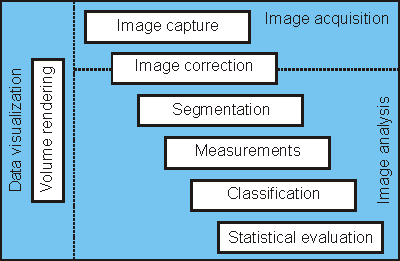
Acquiarium is open source software (GPL) for carrying out the common pipeline of many spatial cell studies using fluorescence microscopy. It addresses image capture, raw image correction, image segmentation, quantification of segmented objects and their spatial arrangement, volume rendering, and statistical evaluation.
It is focused on quantification of spatial properties of many objects and their mutual spatial relations in a collection of many 3D images. It can be used for analysis of a collection of 2D images or time lapse series of 2D or 3D images as well. It has a modular design and is extensible via plug-ins. It is a stand-alone, easy to install application written in C++ language. The GUI is written using cross-platform wxWidgets library.
Image acquisition
Scanning modes
Image acquisition is realized in two stages. (1) A user defines appropriate imaging parameters (e.g., exposure time or camera binning) for every channel and optionally records stage coordinates of interest. (2) A set of multi-channel 3D images is acquired by a certain scanning strategy (called scanning mode). The scanning modes are implemented as dynamic plug-ins.
Acquiarium offers the following scanning modes:
- meander slide scanning,
- scanning of recorded positions in the order Z, lambda, xy,
- scanning of recorded positions in the order lambda, Z, xy,
- time lapse scanning of recorded positions in the order Z, lambda, xy, t
- time lapse scanning of recorded positions in the order lambda, Z, xy, t
- fast continuous capture of one position
Hardware drivers
Acquiarium image acquisition module is based on an abstract microscope model. It encapsulates a fully automated fluorescence microscope based on either a wide-field microscope or a confocal spinning disk microscope equipped with a 2D detector (CCD camera), as well as automation components controlling lateral stage movement, focusing, filter exchange, shutter control, and other microscope parts. Such systems are suitable for fast 3D imaging of both fixed and living cells.
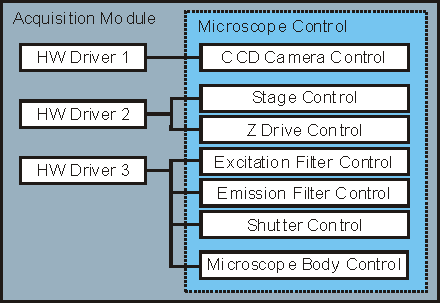
Acquisition module is based on an abstract microscope model consisting of seven different controls. Each control is responsible for a particular automation hardware component. Multiple abstract controls can be driven by the same physical driver. This design allows an easy development of new hardware drivers as well as the development of dummy drivers for simulation or testing. The software can run in different profiles corresponding to different driver configurations on one machine.
Visit the page supported hardware components to see what hardware components our drivers can control.
Image Correction
Fluorescence images suffer from many kinds of degradation, e.g., uneven illumination, uneven CCD chip sensitivity, fluorochrome photobleaching, fluorochrome cross-talk, optical aberrations, blur, noise, etc. Even though many of them can be reduced to a certain extent by purchasing a higher-quality equipment and/or careful optimization of the optical system as well as optimization of acquisition and slide preparation processes, they cannot be avoided completely.
Acquiarium software considers image corrections as an indispensable step in high quality cell analysis. For the time being, it provides a fully integrated support for:
- chromatic aberration correction
- flat-field correction
- automatic or manual shift of color channels
Other corrections are either made by image analysis plug-ins (e.g., noise attenuation, photobleaching correction) or computed by external packages (e.g., deconvolution).
Chromatic aberration correction
Example of chromatic aberration correction on a small fluorescent bead is shown. It is done by the method described in [1].
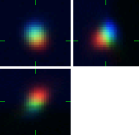
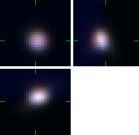
[1] M. Kozubek and P. Matula, âAn efficient algorithm for measurement and correction of chromatic aberrations in fluorescence microscopy,â Journal of Microscopy, 2000.
Flat-field correction
Example of flat-field correction.
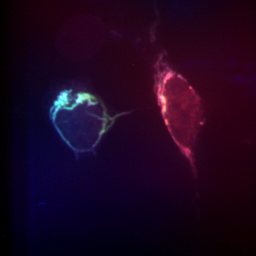

Automatic or manual shift of color channels
Example of automatic correction of chromatic shifts between channels.
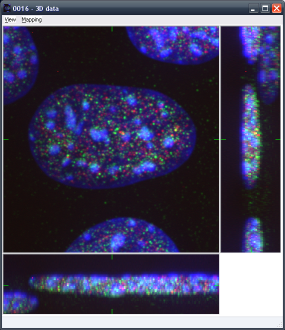
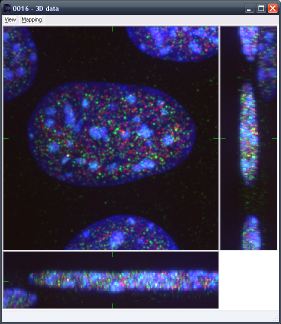 after
after
Data processing plug-ins
…
Screenshots
The following screenshots show several Acquiarium 1.6 windows.
<p>(TODO: Overlaying)</p>
</div>
<div class="col-md-4 col-sm-6 gal-item">
<a href="/images/software/acquiarium/screenshots/plugin-2.png" data-fancybox="gallery" rel="gal"><img src="/images/software/acquiarium/screenshots/plugin-2-small.png" alt="" /></a>
<p>(TODO: plugin-2)</p>
</div>
<!--
<div class="col-md-4 col-sm-6 gal-item">
<a href="/images/software/acquiarium/acq_screen_plugin-2-small.png" class="fancybox" rel="gal">
<img src="/images/software/acquiarium/acq_screen_plugin-2-small.png" alt="" />
</a>
<p>popis fotky</p>
</div>
-->
Tutorials
References
[1] P. Matula, M. MaÅ¡ka, O. DanÄk, P. Matula, M. Kozubek, “Acquiarium: Free Software for Acquisition and Analysis of 3D Images of Cells in Fluorescence Microscopy”, 6th IEEE International Symposium on Biomedical Imaging, Boston, 2009.